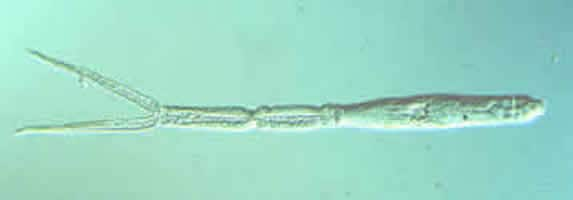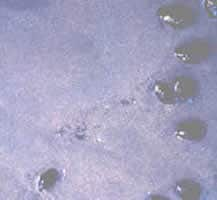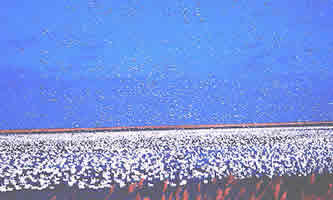
Monthy Case Studies - 2000
Case #37 - June, 2000
A 12-year-old boy was seen in a Delaware physician's office for a pruritic rash on his hands and wrists. His mother reported that two weeks prior, she and her son visited some local marshlands to observe the large flocks of geese that had been sighted in the area. While there, her son noticed some snails along the beaches and wanted to keep them as pets. He collected a dozen snails along with a bucket of sand and water from where he found the snails. After returning home, he set the snails up in a five-gallon aquarium with about two inches of sand and two inches of beach water. She told the physician that her son would occasionally handle the snails in the water bare-handed. The physician asked her to bring some of the snails and water to him so that he could forward the snails to a colleague at CDC for investigation. The following images show what was found in the aquarium water (Figure A) and what the snails looked like (Figure B). The snails averaged about 30 mm in length and the object in the Figure A is about 320 micrometers in length (magnification 100×). What is your diagnosis? Based on what criteria?

Figure A

Figure B
Answer to Case #37
This was a case of cercarial dermatitis caused by exposure to the cercariae of Austrobilharzia variglandis, an avian schistosome. Key diagnostic features of the cercaria in Figure A include:
- the size.
- presence of a forked tail.
- presence of eye spots (Figure A).

Figure A
Collecting live cercariae from infected snails under laboratory conditions can sometimes be difficult. Identification and classification of the cercariae should be done by an experienced parasitologist.
Symptoms from initial penetration of the cercariae can include reddening and itching of exposed skin while one is still in the water or immediately after emerging from the water. Cercarial dermatitis is a delayed hypersensivity reaction that manifests itself with an onset of pruritic raised papules that may become vesicular. Hosts of avian schistosomes include migratory waterbirds such as ducks and geese. Figure C shows the huge number of birds that can be found in wetlands.

Figure C
Adult worms found in the blood vessels of the hosts produce eggs that are passed in the stool. On exposure to water, the eggs hatch and liberate miracidia that can infect suitable molluscan intermediate hosts, usually snails (in this case, Ilyanassa obsoleta). The parasite develops in the snail to produce cercariae that are released in the water and penetrate the skin of birds to complete the cycle. Humans are inadvertent hosts; cercariae penetrate the skin but do not develop further. Outbreaks of cercarial dermatitis occur unpredictably; therefore, a timely public health response depends on early recognition of cases by local physicians who diagnose or suspect cercarial dermatitis rather than a dermatitis of bacterial or other etiology.
Note: Cercarial dermatitis should not be confused with sea bather's eruption. Sea bather's eruption is caused by the larvae of certain jellyfish. The affected area is generally restricted to areas under bathing clothes. Clothing serves to trap larvae next to the skin and then, when one takes a freshwater shower or allows the clothing to dry, the nematocysts are triggered, stinging the individual.
More on: Cercarial Dermatitis
Images presented in the monthly case studies are from specimens submitted for diagnosis or archiving. On rare occasions, clinical histories given may be partly fictitious.
 ShareCompartir
ShareCompartir


